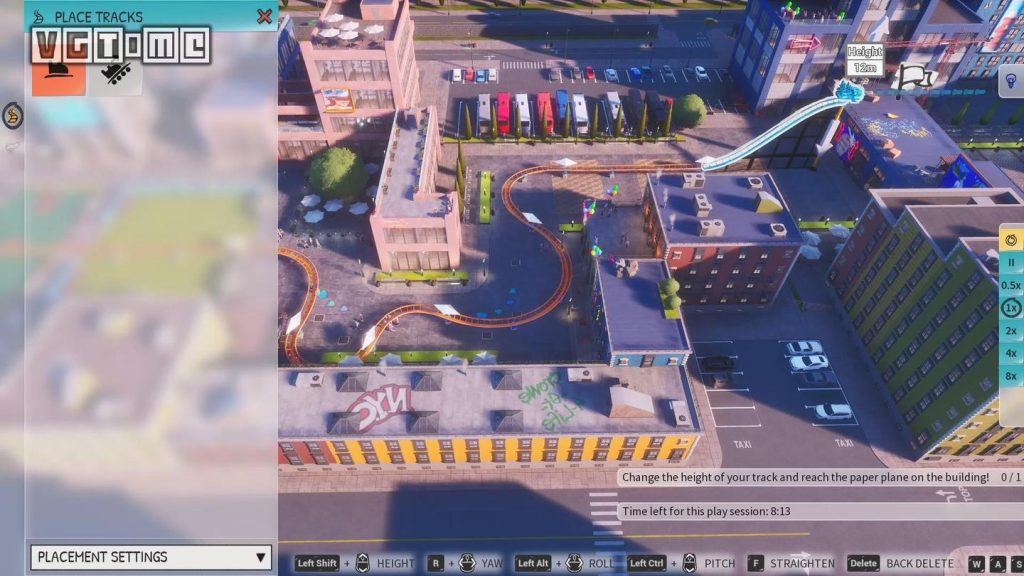For players of management games, “Rhapsody”, developed by Limbic Entertainment and published by Bandai Namco, is a work worth paying attention to. This game takes designing amusement parks as its theme and incorporates rich simulation management elements.
Before the official release of this game, the official team had provided a 15-minute playable version to various media outlets. Although the demo version doesn’t show much content, we can still get a glimpse of the style of “Rhapsody” from it.
I just want to build a roller coaster
In “Fantasy Park”, building roller coasters is an important part of designing an amusement park, and the trial version showcases precisely this aspect. With the guidance of the system, players can build the roller coaster track step by step and smoothly reach the finish line of their roller coaster.

Start setting up the tracks
Before starting the trial play, I was a little worried about my construction skills. First, I have no exposure to professional knowledge in planning, and second, I have a bit of obsessive-compulsive disorder. If I were to create such a crooked and uneven track, I would definitely struggle with myself and have to adjust it until I am satisfied. But by doing so, both the time and the novelty have been wasted in vain.
But when playing “Rhapsody”, I didn’t have the above feelings. In fact, building a beautiful roller coaster track in this game was much simpler than I had imagined, which was quite beyond my expectations.
The trial version offers two types of tracks: “Flat Track” and “Slope Track”. Within the extension range of the current track, players can choose any point as a node and lay the next section of the track on this basis.
Laying the tracks is quite simple
Therefore, the entire process of building the track is just like assembling building blocks, simple yet interesting. Apart from some restrictions caused by the length of the track and terrain factors, players can freely decide the path and height of the track. When selecting the track nodes, the system will also make moderate adjustments to the track shape, which makes the entire road appear more unobstructed.
As long as players wish, they can also lay winding curves or special rolling tracks between the two nodes. The production of these special tracks does not require any additional operations. They can be formed with just a few adjustments on the basis of ordinary tracks.
However, laying tracks is not something that can be done at will. The roller coasters in “Fantasy Land” follow some basic physical rules. If the player builds a steep uphill track, the roller coaster will gradually slow down and even return all the way to the starting point.
Fortunately, the development team has prepared a “Ghost Car” feature, which can help players check themselves at any time and figure out which sections of the road are likely to have problems. When the system marks some target points, it will require players to test with the “ghost Car” first. Only after the test is passed will the next target point be opened. This ensures that the entire game process can proceed smoothly.
The “Ghost Car” can be directly adjusted to 8 times its speed
During the process of building the track, I also discovered some small tricks, such as designing various “big downhill” tracks or placing gun emplacements at intersections. These measures can all enable the roller coaster to keep accelerating and reach the finish line in one go.
After the track laying is completed, players can experience the roller coaster track they have built from a first-person perspective. Accompanied by cheerful background music, I got on the roller coaster I made by hand. The falling runway stimulated my senses, and the feeling of the flying car soaring in the air after the cannon was fired was also quite wonderful. While enjoying the pleasure of the ride, I also gained a great sense of achievement.
Just go for it
Both a designer and a manager
In addition to the basic level of building a roller coaster track, this trial version of “Fantasy Land” also showcased the so-called “sandbox mode”.
In sandbox mode, players take on the role of the designer of the entire amusement park. The system will provide players with an initial sum of money and open several types of amusement facilities in advance. All the players need to do is to set up these facilities, control the budget well, and then just wait for the tourists to come.
For some players of management games, this mode is sure to look familiar to them. As planners of amusement parks, players need to rationally allocate their resources, do their best to maintain a good reputation among customers, and then find ways to make the amusement park profitable. It’s obvious that this is a classic simulation management gameplay.
Apart from the ready-made amusement facilities, I also found some interesting things on the construction interface: all kinds of parts. I took a cursory look and found that these parts included landscape trees, flower beds, guiding signs and so on, as well as large and small building boards. Together, there were hundreds of types. In other words, apart from roller coaster tracks, players can also create more novel things with parts. By the way, the prices of these building parts are all very low.
The official promotional video also showcases the corresponding features. As long as players use enough parts, they can decorate an ordinary ice cream shop to be super luxurious. Because of the rich variety of parts, players can even adopt multiple decoration styles. In my opinion, these elements further highlight the joy of “creation” in the game.
An ice cream shop that has completed its decoration
The management gameplay and the creation of facilities do not represent the entire content of the game. In an earlier media interview, the creative director of this game, Johannes Reithmann, mentioned the story mode, which is also the part I most hope to play.
Unfortunately, there is no detailed content about the story mode in this trial play. However, several important NPCS have already made their appearances in the game, such as the mischievous assistant Blaize; Enthusiastic park owner Phil; The serious administrative staff member lzzy. After the trial play begins, Blaize will be by the player’s side. She will communicate with players at the right time and help them unlock more options. Phil will greet the player warmly after they complete the level.
According to the official introduction, when taking on tasks in the story mode, players will communicate with different NPCS to determine what strategy to use to operate the amusement park. Players will face different choices and also need to consider the risks and returns of the corresponding plans.
There are relevant plots in the trial version
In the story mode, some new characters will also appear. They might add a bit of difficulty to the player’s tasks or require persuasion. Different tasks involve conditions such as time constraints or profit limits, and sometimes it is also necessary to consider whether there is sufficient construction space. If some NPCS buy all the plots near the amusement park, players will have to face the result of “Game Over”.
In my opinion, these characters and challenges make the world of “Rhapsody” more interesting. I could choose to operate the amusement park alone in a sandbox mode at a leisurely pace, but in comparison, I would rather not feel so lonely when building it. I hope that while expanding the park, I can experience all kinds of wonderful stories and meet more reliable companions. I hope the story mode of “Fantasy Land” can meet my needs.
Conclusion
Judging from this trial version alone, “Fantasy Land” still has some minor issues, such as the functional interface not being simple enough and the Chinese translation not being perfect. However, these flaws do not affect my enjoyment of the game. All the mechanisms in “Fantasy Park” are very simple. Once beginners master the basic operations, they can play it easily. After understanding the basic mode, players can fully experience the sense of achievement from “building” and “managing”.

